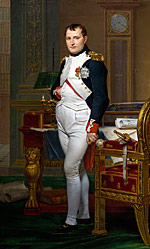
Unit 3: Revolutions and Reaction
Lesson C: Impact of the Atlantic Revolutions on Europe
Lesson Overview
In the wake of the French Revolution, the world faced many difficult questions. Would democratic governments spread to other countries in Europe? Would democracy spread around the world? Or, would absolute monarchy regain its footing? The events in France during the early 19th century provided an answer to this question. Napoleon Bonaparte ruled France extending some of the political and cultural changes of the French Revolution, but reversing others. His rule and military prowess challenged the traditional powers, leading to lasting change. This lesson explores the impact of Napoleon on Europe and the world.
Key Questions
- How and why did the spread of Enlightenment (Age of Reason) and revolutionary ideas transform existing political and social systems throughout the world?
- How did the ideas of liberalism and nationalism unite the people of Europe?
- What distinguishes unsupported expressions of opinion from informed hypotheses grounded in historical evidence?
Student Outcomes
- Assess the extent to which the ideals of the French Revolution were suppressed as a result of the Congress of Vienna.
- Analyze the effects of the revolutions of the 1830s and 1840s on the long-term struggle to achieve the ideals of liberty in Europe.
- Examine the influence of nationalism in the call for liberty and government reform throughout Europe.
- Analyze how the Enlightenment ideas of liberty, equality, fraternity, and nationalism spread throughout Napoleon's empire and how the ideals of the revolution inspired revolts against absolute governments into the 20th century.
- Explain how the French Revolution transitioned from constitutional monarchy to autocratic rule under Napoleon.
- Analyze cause-and-effect relationships and multiple causation, including the importance of the individual and the influence of ideas. (Historical Thinking Skill)
Key Terms
Student Resources
- The Rise and Fall of Napoleon (doc)
- The Actions of Napoleon - Change or Continuity? (doc)
- Nationalist Revolutions of the 19th Century
- Change or Continuity Brief Constructed Response (BCR) (doc)
Chart of Activities:
| Activities to Complete | Estimated Time |
|---|---|
| Pre-Assessment | 5 minutes |
| Key Terms | 5 minutes |
| Activator: The World 1789-1850 | 5 minutes |
| Opening: Setting Goals | 10 minutes |
| Activity 1: Goals of the Revolution | 10 minutes |
| Activity 2: Know your Goals | 20 minutes |
| Activity 3: The Rise and Fall of Napoleon | 10 minutes |
| Activity 4: The Ideals of Napoleon | 20 minutes |
| Activity 5: The Congress of Vienna | 5 minutes |
| Activity 6: Goals of the Congress of Vienna | 10 minutes |
| Activity 7: The Holy Alliance | 10 minutes |
| Activity 8: Nationalist Revolutions | 30 minutes |
| Activity 9: A Timeline of Revolution | 10 minutes |
| Review and Assessment | 10 minutes |
| Lesson Summary | 5 minutes |
Lesson Completion Time
The total estimated time to complete this lesson is 165 minutes.
Page Notes:
[1] Source: This image from http://en.wikipedia.org/wiki/File:Napoleon_in_His_Study.jpg is in the public domain because its copyright has expired.



